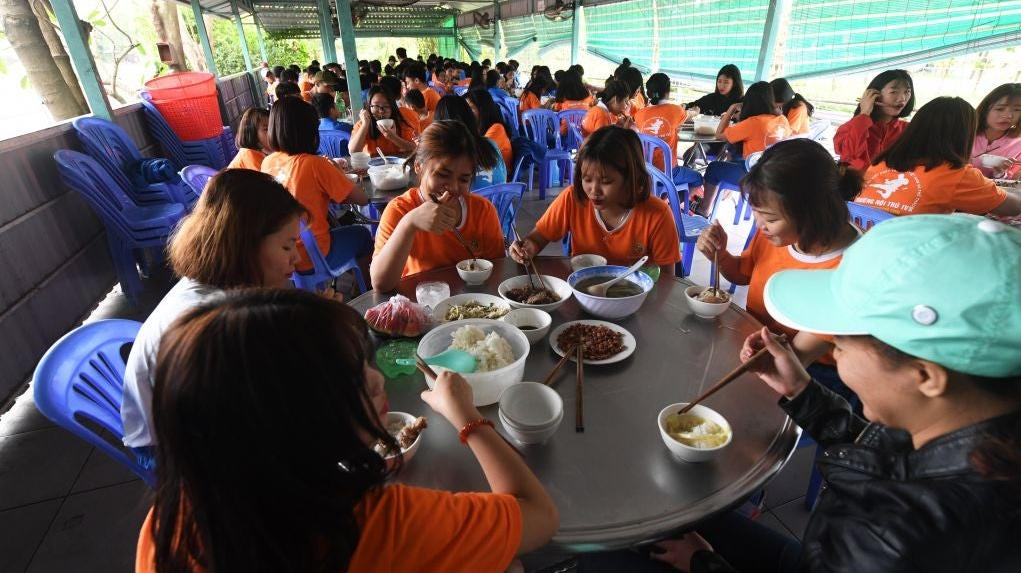In Vietnam, School Lunches Look Different
What moving to the United States from Vietnam taught me about how kids eat.
The thing I remember most about my preschool and primary school days in Vietnam is the fact that it was run by Catholic nuns. While schools helmed by nuns have become less common these days, particularly in North America, the majority of people were Catholic where I grew up, a small village outside of Ho Chi Minh City. By the time I was old enough to attend school, there was no question that I'd attend a Catholic one.
When I came to America in 1995, I left behind my primary school years, and with them, the chaos of eating with my classmates. Admittedly, it's been a while since I stepped foot inside a Vietnamese school, and I'm aware that my memories may be hazy. To see whether they match up with reality, I interviewed my niece and two nephews, all of whom attended both primary and secondary schools in Vietnam in the mid-to-late 2000s. Our conversation yielded many insights about the Vietnamese school lunch system, including its pitfalls.
Below are some of their observed differences, coupled with my own.
Foods are more colorful and always include rice
First, let's talk about the positive: rice. Vietnam is a big producer of rice, accounting for 43.85 million metric tons produced in 2021. A typical meal for a child (or any adult, for that matter) will include rice. Along with that comes a protein-based entrée, or món mặn (for example: fried fish, tofu, chicken curry or ca ri, and sometimes grilled pork if available), but it can also be a stir fry type of dish, or món xào, such as stir fried long beans. Along with that comes a palate-cleansing side dish called tráng miệng, which can include fresh fruits like durian, guava, lychee, or dragon fruit. A serving of soy milk or che, the famous Vietnamese three-layer dessert, might be paired with the meal.
Lunch periods are a lot longer
Luan, my oldest nephew, told me that it was common for him and his siblings to go home for lunch. When I asked why, they told me that it's mainly due to necessity rather than proximity. They attended a small town school that did not have the resources to provide lunch. Students typically get one snack per school session, of which there are two: a morning session, which runs from 7 a.m. to noon, and afternoon session, from noon to 5 p.m. Each student attends one or the other. They mostly attended the morning session; by the time they were done with school, it was time for lunch.
Of course, there are schools that serve lunch to students, but those are more likely to be located in the cities, or they're schools with better financial resources. While lunch in American schools is typically 30 minutes, lunch in Vietnam is at least an hour and a half, up to two hours. This gives the child plenty of time to go home and eat, should they wish to do so, and enjoy their meal.
Parents are responsible for their child’s lunch
In America, the public school system means that a child's class standing is often obscured; in Vietnam, these divisions are much more public. Where you send your child to school is an indicator of your wealth (or a lack thereof), because parents have to pay for their child's full tuition, books, and other materials. As a result, they're highly sensitive and acutely aware of how much each school costs.
Food happens to be part of the "other materials," something that parents are generally responsible for. If the school serves food, that's great, but in general, there is nothing resembling America's universal free lunch programs. As imperfect as those programs might be, they provide coverage that Vietnamese schools do not.
Government subsidies are practically nonexistent
One of the things that shocked me when I came to America and started attending public school was the fact that my parents didn't have to pay for it. What was even more shocking was that they didn't have to pay for my lunch either, thanks to the "free and reduced lunch program," or NSLP.
Due to the way the education system is structured, Vietnam has no such subsidies. In some provinces, such as Nghe An province in central Vietnam, they've implemented a boarding school model, where they provide lodging and food for children, but those efforts are few and far between. While some American school districts might not see a majority of students opt for the free lunch, the fact that it's an available option is invaluable.
School lunch programs are improving
Feeding thousands of children a day continues to be a challenge in Vietnam, where no standardized school meal plans are in place. Adding to that challenge is the fact that those who prepare food and feed children do not necessarily have educational credentials in nutrition.
However, in the past decade, efforts have been made (such as this one and this one) to provide children with a more balanced and standardized meal option similar to what students in Japan are served. As of right now, Vietnamese children do not have the benefit of a nationwide, government-sponsored and standardized nutrition program, but things seem to be moving in the right direction.
